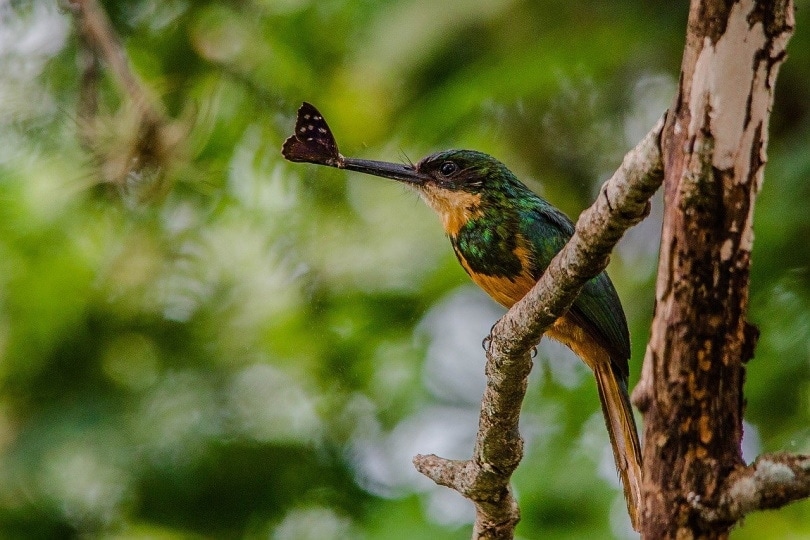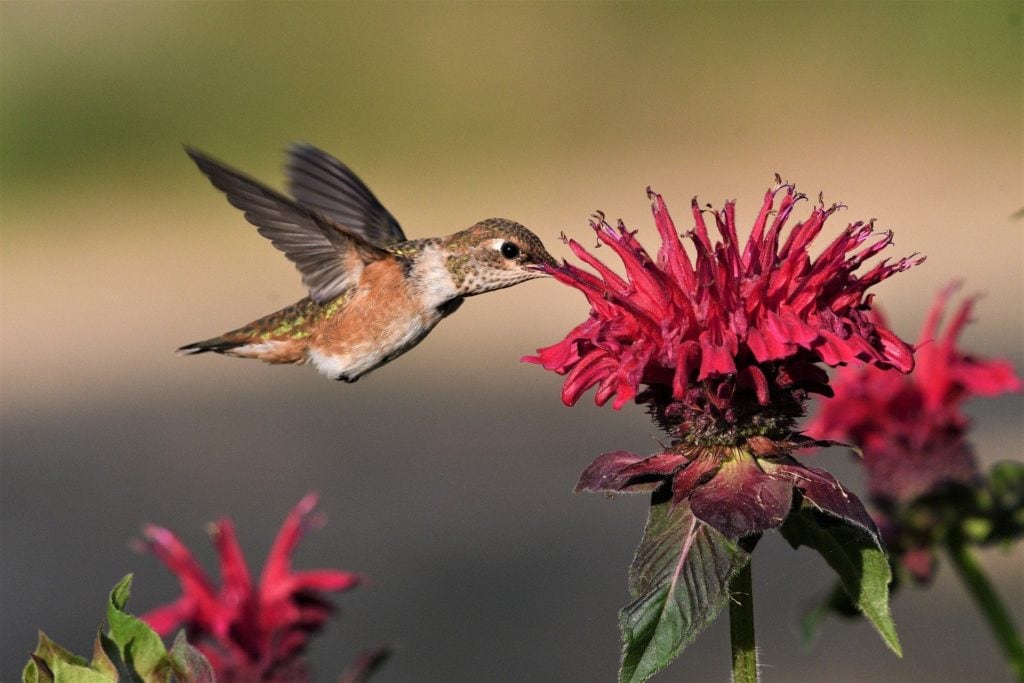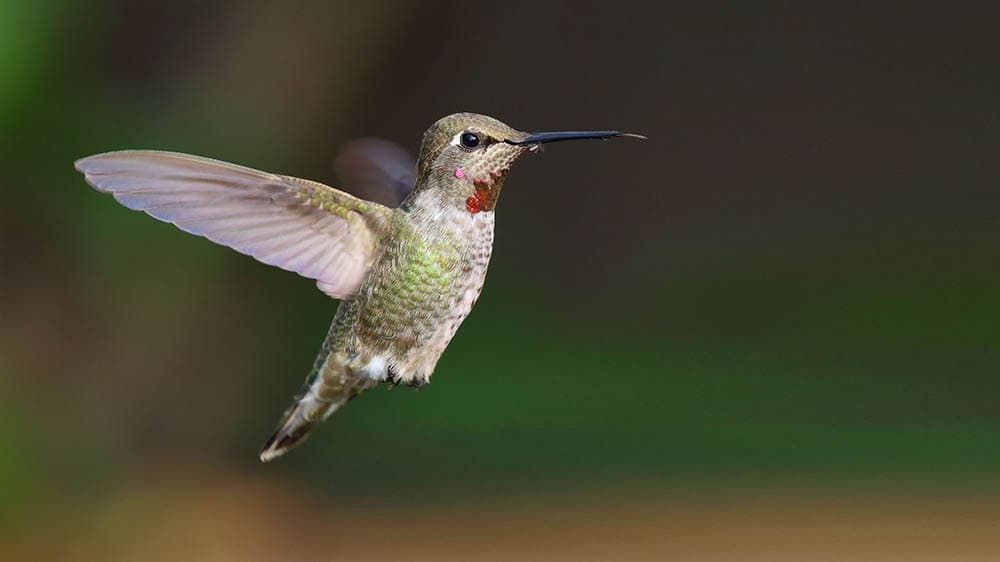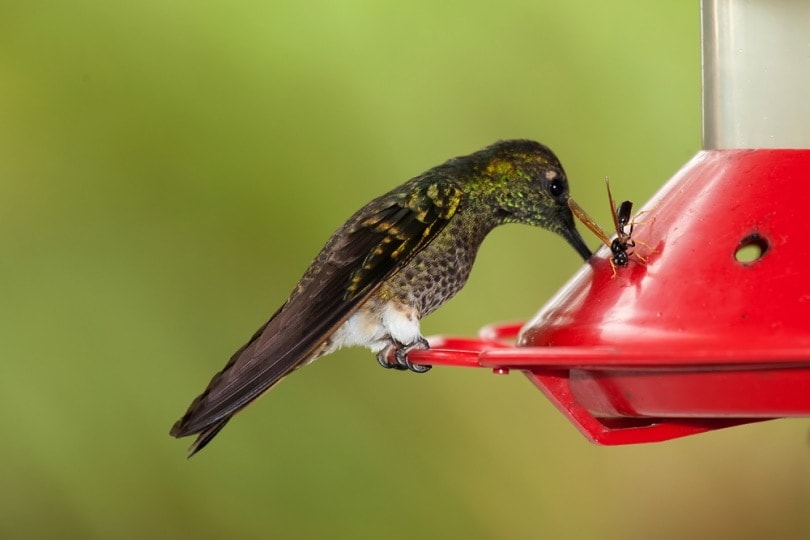Do Hummingbirds Eat Bugs and Insects? What You Need To Know!
Last Updated on

When you think of hummingbirds, what first comes to mind? Probably the feeders you place outside your home to attract them — the ones filled with sugar water. Hummingbirds are huge fans of sweet substances such as sugar water and flower nectar.
But do they eat other things, such as bugs and insects? Hummingbirds do eat bugs and insects! In fact, they feed on a wide variety of them.

A Hummingbird’s Diet
For quite a bit, it was assumed that hummingbirds lived strictly off sugary foods (and it’s true that a substantial part of their diet is made up of things like nectar, tree sap, and juices from fruit). Believe it or not, hummingbirds can consume almost half their body weight in sugar daily! However, hummingbirds also require protein, vitamins, and minerals like all birds do. This is where bugs and insects enter their diet.
Why Bugs & Insects Are Important to Hummingbirds Diets
Bugs and insects contain a multitude of nutrients hummingbirds need in their daily diets besides protein, vitamins, and minerals. They also provide fiber, fats, oils, and amino acids to hummingbirds. Without the addition of bugs and insects, hummingbirds could suffer nutritional deficiencies. And when it comes to their need for protein, one study on hummingbirds in captivity found that in the wild, hummingbirds will eat up to three times the minimum amount of protein needed.


Bugs & Insects Hummingbirds Eat
When it comes to the bugs and insects that hummingbirds enjoy munching on, they have a preference for arthropods (or invertebrates) with soft bodies (though if none are around, the birds will eat other types). They may eat dozens to hundreds (or more!) insects a day. Some of the bugs and insects hummingbirds may consumer include:
- Ants
- Aphids
- Flies
- Gnats
- Harvestmen
- Leafhoppers
- Mites
- Mosquitoes
- Small beetles
- Spiders
- Weevils
How Hummingbirds Hunt
It’s difficult to picture hummingbirds as predators, given their small stature (and cuteness). But these birds are quite adept when it comes to hunting down their prey and are able to capture bugs and insects in a couple of different ways.
The first is by grabbing them off flowers, leaves, and bark, or even stealing them from where they’ve been trapped in spiders’ webs. The second way is by catching them in the air as the hummingbirds hover or go back and forth within an area in small bursts. These birds have pretty amazing eyesight, so it’s easy for them to see insects flying in their vicinity and be able to snatch them up. (It also helps that their brains can take in visual stimuli from all directions.)
But how are hummingbirds able to snap up bugs and insects with those long, thin bills of theirs? It turns out those bills are powerful and fast! The way a hummingbird’s beak is shaped allows for something called snap-buckling, which means that after being opened, their beaks snap closed again in less than a hundredth of a second. This enables them to snatch up bugs and insects quickly.

How To Feed Bugs & Insects to Hummingbirds
If you’re interested in helping your hummingbird pals out on their bug hunting conquests, there are a few ways you can do so. First and foremost, though, do not try putting out bugs in a feeder. Hummingbirds want to eat bugs and insects in their natural, raw forms, so they won’t touch dead or dried bugs that are put out for them.
However, you can try to attract live bugs, such as gnats, to feeders. The best ways to do this? The first is by creating a fruit plate of sorts. Chop up a few fruits such as oranges or bananas, then place them on a hanging feeder. In a few days, insects will be buzzing around, and any hummingbirds in the area should come to investigate.
The second-best way is by creating a fruit slurry. Mix fruit syrup from a can, bananas that have been mashed, a spoon of sugar, a hint of nectar, and a spoon of cake batter until it has reached the consistency of brownie batter. Now, take that delicious treat and spread it over bits of the trees in your yard. Insects will be attracted, and hummingbirds should quickly follow to snap them up.
Fruit plates and fruit slurries aren’t the only ways to attract bugs to your yard, though! You can also try the following.
- Letting your grass grow a bit longer to attract gnats and flies.
- Leaving spiderwebs alone. We know it’s tempting to get rid of all spiderwebs you find, but since hummingbirds like to heist treats from them, they’ll appreciate the webs being left alone.
- Invest in some good, fruitful plants. Installing berry bushes or fruit trees in your yard will attract not only insects but the hummingbirds themselves. Bonus — you get to eat fruit too!


In Conclusion
Hummingbirds do indeed eat bugs and insects. In fact, these make up quite a bit of their diets, as they offer protein, vitamins, minerals, and more that hummingbirds need to survive. Hummingbirds can catch bugs and insects in a variety of ways with the use of their exceptional eyesight and fast snapping bills. And, if you want to give your local hummingbird population a helping hand in finding more to eat, we’re sure they’d be thrilled!
Featured Image Credit: dalmoarraes, Pixabay
About the Author Robert Sparks
Robert’s obsession with all things optical started early in life, when his optician father would bring home prototypes for Robert to play with. Nowadays, Robert is dedicated to helping others find the right optics for their needs. His hobbies include astronomy, astrophysics, and model building. Originally from Newark, NJ, he resides in Santa Fe, New Mexico, where the nighttime skies are filled with glittering stars.
Related Articles:
What Is the Best Binocular Magnification for Hunting? Optical Features Explained
Can You Use Binoculars to Look At Stars? How to Choose the Right Pair
How to Clean a Refractor Telescope: Step-by-Step Guide
How to Clean a Telescope Eyepiece: Step-by-Step Guide
How to Clean a Rifle Scope: 8 Expert Tips
Monocular vs Telescope: Differences Explained (With Pictures)
What Is a Monocular Used For? 8 Common Functions
How to Clean a Telescope Mirror: 8 Expert Tips
